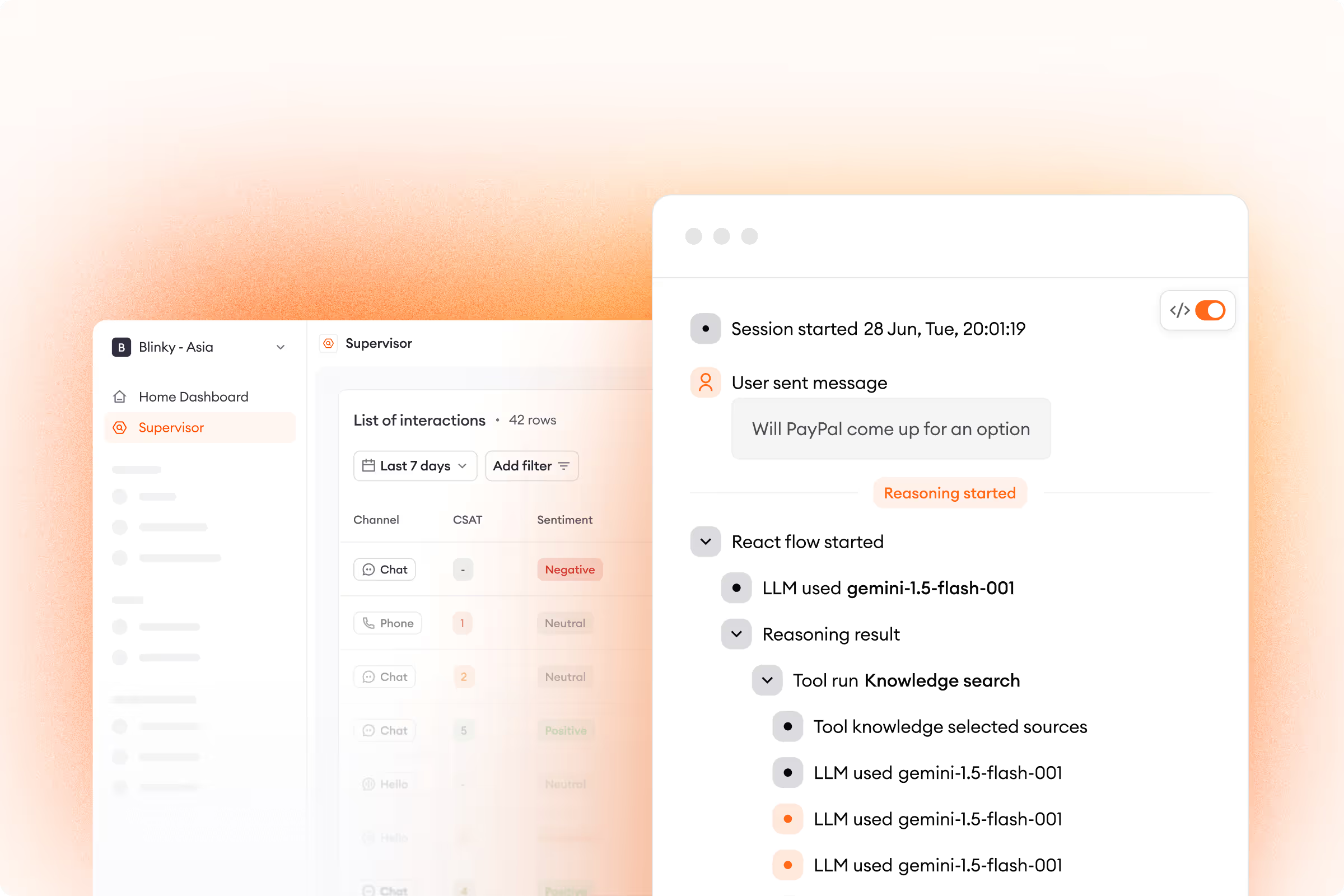Artificial intelligence (AI) is transforming customer service in ways few of us could have imagined. In just a couple of years, experts predict AI will automate up to 95% of all customer interactions.
Teams looking to enhance the customer experience know they can’t go it alone — adding an AI chatbot to their customer service strategy is vital.
But selecting the right AI-powered chatbot for your customer service department is easier said than done. With countless choices offering a multitude of features, zeroing in on a single option is tough.
Where should you start? Right here.
This guide will walk you through the biggest pain points chatbots can help with as well as the most powerful features you should be on the lookout for. Exploring chatbots doesn’t have to be a hassle — read on to see how simple it can be.

How to identify your AI chatbot needs
Before looking at AI chatbots to boost your customer service, it’s important to take a step back and consider exactly why you need a chatbot. Automation platforms have diverse capabilities — some tools excel at a variety of tasks, while others have a narrow specialization. Decide what you’d like to accomplish first, and then investigate which tools will best help you achieve those goals.
Here are the most common pain points companies have that prompt them to look into AI customer service chatbots:
1. Increased ticket traffic
For many businesses, the primary motive for exploring customer service automation is to handle a significant increase in support tickets. As a company grows, more customer queries come in, and support agents see a noted uptick in their workload. To deal with this, companies traditionally take one of three paths.
Hiring additional agents is frequently slow, costly, and ultimately unsustainable. On the other hand, outsourcing your customer support can often work as a temporary fix, but doing so might jeopardize your brand voice as third-party agents usually aren’t as familiar with your product or customer needs. A third option, an AI customer service chatbot capable of answering up to 80% of standard customer requests, could be the optimal way of freeing up your agents to focus on more meaningful tasks.
2. More customer requests outside operating hours
Sometimes, when customers start a conversation is just as important as how many requests you’re getting. Closing your business at 5:00 pm doesn’t mean customers will stop seeking assistance after hours. If your agents are starting each day playing catch-up with a mounting backlog, your team is likely a good candidate for automation. Instead of dealing with lengthy queues and subpar metrics, companies that embrace AI chatbots can essentially add another support agent — one that’s always available without a queue.
3. Inconsistent support across channels
For anyone who wants to deliver top-notch service, it’s crucial to meet customers where they are. Companies need to offer support over chat, email, social media, and other channels to ensure customers feel like they’re receiving the VIP treatment. However, syncing your support channels is easier said than done.
Companies often create vastly different experiences for customers depending on which channel they interact with. For example, a shopper who asks a question over live chat may get their issue resolved immediately, but one who sends an email may have to input their personal data multiple times, get transferred to another agent, and wait days to get a response. This inconsistency can frustrate shoppers and send customer satisfaction plummeting.
Instead, businesses need to identify an omnichannel solution that allows them to deliver the same high-quality experience regardless of which channel shoppers use.
4. Uncertainty surrounding growth into new markets
A thriving business is bound to attract international customers. How can you most effectively help shoppers across different time zones — and in foreign languages? Hiring human agents in each local market is rarely feasible. It’s costly, time-consuming, and a logistical nightmare. How would you recruit a German-speaking agent? And what’s a fair wage to pay them? Where do you even begin?
That being said, you don’t want to shy away from international customers just because of a little speed bump. Expanding to new markets helps your business access an untapped audience, but catering to a new customer base presents a formidable challenge to many service teams.
A chatbot could be exactly what you need — a multilingual support member capable of interacting with customers in their preferred language.
5. Cost pressures related to customer service
Many support teams turn to automation in an attempt to lower costs associated with serving customers. In several organizations, customer service departments are viewed as cost centers that are vulnerable whenever cost-cutting measures must be taken.
Teams facing pressure to streamline should consider a customer service chatbot as it lets them stay lean and mean. On top of this, any support managers looking to quantify their team’s contributions to the business as a whole ought to welcome automation platforms that track metrics and lay out how each agent has performed, whether it’s resolving issues or closing sales.
Understanding the limitations of AI chatbots
There isn’t much customer service chatbots can’t do, but they most certainly have their limitations. For instance, while automating FAQs is essential, AI chatbots should never attempt to automate 100% of your customer interactions. A chatbot likely won’t satisfy customers with complex cases needing urgent assistance — it’ll only frustrate them.
Picture the following customer chat:
I’d like to buy my mother a birthday present. Her interests are painting, nature, and photography. Could you recommend anything?
Using a chatbot for such a complex case wouldn’t be ideal. Agents specialized in your products can deliver much more valuable advice.
In that same vein, customer service chatbots aren’t capable of fully replacing human support agents. As good as generative AI is at detecting a shopper’s sentiment and recreating natural conversations, it still can’t perform all the tasks that a human representative can.
Human agents are your brand ambassadors and product experts. AI won’t replace them — it simply boosts their efficiency and lets them leverage their expertise to create meaningful connections.
What to look for in an AI chatbot
Now that we know the main reasons you might need a customer service chatbot, let’s look through the top features automation platforms boast to actually address these needs:
1. Lightning-fast implementation
If you want an AI customer service chatbot to handle the brunt of your customer chats, you’ll need something that requires minimal implementation time. Any platform will get up and running — eventually — but clunkier solutions will eat up valuable time and resources from the very beginning.
You shouldn’t have to wait around for an IT specialist to configure an AI tool to read through your knowledge base. Leading tools can start producing meaningful automation rates in days, with an onboarding time commitment as short as three hours. And no-code setup means these chatbots, preloaded with the most common automations out there, can seamlessly integrate with your tech stack and start performing without delay.
2. Personalized 24/7 support
With an AI chatbot that’s always on, agents will have the breathing room to handle cases with care and forge more meaningful connections with shoppers. A chatbot’s ability to give immediate answers doesn’t just augment the agent experience — it also brings sizable improvements to metrics like first response and resolution times.
And the best customer service platforms are capable of interacting with shoppers in engaging, natural ways. By relying on advanced large language models (LLMs) and natural language processing (NLP), these AI chatbots can delight customers with exchanges that feel like they’re coming from a human agent.
3. Omnichannel capabilities
An AI customer service chatbot should seamlessly link all your channels to give you a true omnichannel platform. This ensures you’re bringing shoppers consistent support. Setting up a virtual assistant on live chat is a good start, but up to 60% of all support tickets come via email. Leading AI chatbots can serve customers on any channel, including email and social media. Not only that, but they share customer information across channels to help customers progress further in their journey instead of having to start over whenever switching channels.

4. Multilingual help
If you want to go international and deliver support in new languages and time zones, an AI chatbot can provide heaps of help. And deploying a multilingual chatbot isn’t just doable — it’s often remarkably efficient. AI chatbots enable businesses to go global and answer questions in each customer’s preferred language. The best solutions out there can respond in and translate no fewer than 48 languages, even if misspellings are present. They can even identify and switch languages mid-conversation.
Going international doesn’t take an army of agents. All you need is a customer service chatbot.
5. Support-driven revenue
Yes, AI automation can improve support metrics and delight customers, but customer service chatbots can also have a phenomenal impact on an organization’s bottom line. By removing hiring pressure — both long-term and seasonal — automation platforms typically keep costs in check. In addition, many are equipped to convert customer support into sales by generating support-driven revenue.
By detecting buying intent and proactively reaching out to customers at critical touch points of the customer journey, chatbots can guide shoppers closer to checkout. They also create customized product recommendations, showing customers unique offers that they’re most likely to purchase. In doing so, today’s top AI chatbots are transforming support teams from cost centers into revenue centers.
Picking the right AI chatbot — made easy
We get it — finding the right customer service chatbot might feel like finding a needle in a haystack. Hopefully, our guide did the dirty work for you and clarified what you should be on the lookout for.
Whatever your particular needs, any AI customer service chatbot worth its salt makes setup a breeze, creates personalized experiences, and unlocks your revenue-generating potential — in any language, on any channel.
Zowie has already equipped hundreds of support teams with everything they need to delight customers with exceptional experiences.

.avif)







